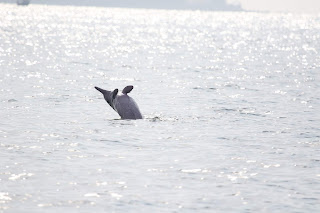Taxonomy:
The
Indo-Pacific humpback dolphin (Sousa chinensis) is included in the order Cetacea, suborder Odontocetes (Toothed cetacean) and family Delphinidae.
Fig 1. Moving behaviour of an adult dolphin (Photo: Rajitha)
Fig 2. Breaching of a dolphin (Photo: Rajitha)
.
Characteristics
habitats
and values:
Young is black or is grey, the adult
is pink. The pink colour of the body is not caused by pigments, but by the
blood vessels under the epidermis, which is related to the regulation of body
temperature. Chinese white dolphins rarely enter waters deeper than 25 m. Their main habits are mangrove waterways,
bays, tropical river deltas or brackish waters along the shoreline, in the
Eastern Indian and Western Pacific oceans. The Chinese white dolphin has small
eyes and poor eyesight. Its orientation and orientation mainly depend on the
echolocation system. It is of great scientific in bionics, species evolution
and biodiversity etc.
The Chinese white dolphin is not
unique to China, although it bears the name “China”. It is estimated that as of
2016, there were more than 1,800 white dolphins in the country that could be
counted. Exhibit great plasticity in the production of sounds, including
echolocation clicks and whistles. These whistles are continuous, narrowband, frequency-modulated
sounds that are primarily used in communication with conspecifics. Bycatch,
ship collision and ocean industry noises are the main reason for the decline of
resources.
Conservation:
Endangered and Protected listed in
the List of National Key Protected Wildlife; class I, Red List of Species in China;
Endangered (EN), CITES Appendix I, The IUCN Red list; Near Risk(NT,2008). Now
it has established Marine Species National Nature Reserve and Pearl river
estuary Chinese White Dolphin National Nature Reserve. In recent years, due to
the increase in conservation measures, the population of white dolphins has increased,
but the conservation situation is still serious.




4 comments
Click here for commentsgood stuff , keep it up
ReplyThank you Isuru
ReplyInteresting, keep it up. ��
ReplyThank you.. 👍
ReplyConversionConversion EmoticonEmoticon